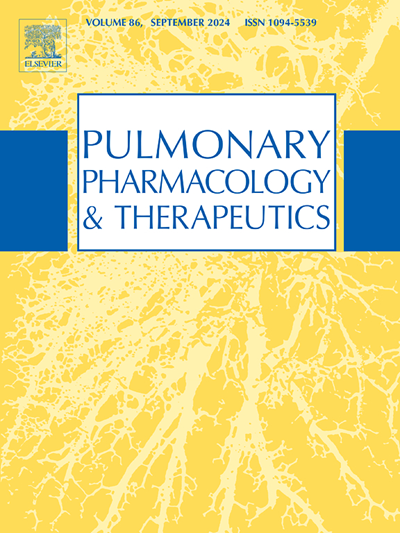使用重复剂量的博来霉素和香烟烟雾提取物对小鼠肺纤维化和合并肺气肿的实验建模
IF 2.8
3区 医学
Q2 PHARMACOLOGY & PHARMACY
引用次数: 0
摘要
特发性肺纤维化(IPF)患者中吸烟的高患病率增加了肺气肿的风险。合并肺纤维化和肺气肿(CPFE)主要发生在男性中,其特征是严重的运动性呼吸困难,弥散能力下降,肺癌风险增加。将CPFE患者排除在临床研究之外,限制了对其病理生理、治疗和预后的了解。本研究旨在通过在动物模型中比较CPFE与纯IPF来缩小这一知识差距,旨在开发以表型为导向的治疗策略。方法8周龄雌性C57BL/6J小鼠每2周气管内注射博来霉素(BLM, 2 U/kg/100 μL) 3次。对于CPFE模型,每周两次给予额外的鼻内香烟烟雾提取物(CSE)。通过支气管肺泡灌洗液(BALF)、促炎细胞因子、纤维化标志物和肺组织学来评估炎症和纤维化。结果balf分析显示,所有blm处理组细胞计数增加,主要是巨噬细胞,白细胞介素(IL)-6、转化生长因子(TGF)-β1和基质金属蛋白酶(MMP 3和MMP 8)升高。BLM和CSE治疗组巨噬细胞和淋巴细胞计数高于BLM单独治疗组。肺组织分析显示,blm处理组羟脯氨酸、炎症评分、Ashcroft评分升高,α-平滑肌肌动蛋白(SMA)和胶原蛋白1表达升高。通过平均线性截距(MLI)测量,BLM和CSE治疗组的肺气肿形成明显增加。结论通过反复给予BLM和CSE暴露,建立了持久肺纤维化和肺气肿的有效模型,可以进行CPFE和IPF的临床前研究,并探索以表型为导向的肺纤维化治疗策略。本文章由计算机程序翻译,如有差异,请以英文原文为准。
Experimental modeling of pulmonary fibrosis and combined emphysema in mice using repeated doses of bleomycin and cigarette smoke extract
Rationale
A high prevalence of smoking among idiopathic pulmonary fibrosis (IPF) patients increases the risk of emphysema. Combined pulmonary fibrosis and emphysema (CPFE) occurs predominantly in males, characterized by severe exercise-induced dyspnea, decreased diffusing capacity, and increased lung cancer risk. The exclusion of CPFE patients from clinical studies has limited understanding of its pathophysiology, treatment, and prognosis. This study aimed to close this knowledge gap by comparing CPFE with pure IPF in animal models, with the intent of developing phenotype-directed therapeutic strategies.
Methods
Eight-week-old female C57BL/6J mice received biweekly intratracheal bleomycin (BLM, 2 U/kg/100 μL) for 3 doses. For the CPFE model, additional intranasal cigarette smoke extract (CSE) was administered twice weekly. Inflammation and fibrosis were evaluated through bronchoalveolar lavage fluid (BALF), proinflammatory cytokines, fibrosis markers, and lung histology.
Results
BALF analysis showed increased cell counts in all BLM-treated groups, primarily macrophages, with elevated interleukin (IL)-6, transforming growth factor (TGF)-β1, and matrix metalloproteinases (MMP 3 and MMP 8). The BLM and CSE treated group displayed higher macrophages and lymphocytes counts than BLM alone. Lung tissue analysis revealed increased hydroxyproline, inflammation scores, Ashcroft scores, and higher α-smooth muscle actin (SMA) and collagen 1 expression in BLM-treated groups. The BLM and CSE treated group demonstrated notably higher emphysema formation as measured by mean linear intercept (MLI).
Conclusions
Through repeated BLM administrations and CSE exposure, an effective model for persistent pulmonary fibrosis and emphysema was established, enabling preclinical studies on CPFE and IPF and exploration of phenotype-directed therapeutic strategies for pulmonary fibrosis.
求助全文
通过发布文献求助,成功后即可免费获取论文全文。
去求助
来源期刊
CiteScore
6.20
自引率
0.00%
发文量
41
审稿时长
42 days
期刊介绍:
Pulmonary Pharmacology and Therapeutics (formerly Pulmonary Pharmacology) is concerned with lung pharmacology from molecular to clinical aspects. The subject matter encompasses the major diseases of the lung including asthma, cystic fibrosis, pulmonary circulation, ARDS, carcinoma, bronchitis, emphysema and drug delivery. Laboratory and clinical research on man and animals will be considered including studies related to chemotherapy of cancer, tuberculosis and infection. In addition to original research papers the journal will include review articles and book reviews.
Research Areas Include:
• All major diseases of the lung
• Physiology
• Pathology
• Drug delivery
• Metabolism
• Pulmonary Toxicology.

 求助内容:
求助内容: 应助结果提醒方式:
应助结果提醒方式:


